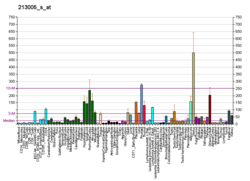| KANK1 |
|---|
|
| Identifiers |
|---|
| Aliases | KANK1, ANKRD15, CPSQ2, KANK, KN motif and ankyrin repeat domains 1 |
|---|
| External IDs | OMIM: 607704; MGI: 2147707; HomoloGene: 17706; GeneCards: KANK1; OMA:KANK1 - orthologs |
|---|
| Gene location (Human) |
|---|
 | | Chr. | Chromosome 9 (human)[1] |
|---|
| | Band | 9p24.3 | Start | 470,291 bp[1] |
|---|
| End | 746,105 bp[1] |
|---|
|
| Gene location (Mouse) |
|---|
 | | Chr. | Chromosome 19 (mouse)[2] |
|---|
| | Band | 19|19 B | Start | 25,214,339 bp[2] |
|---|
| End | 25,411,860 bp[2] |
|---|
|
| RNA expression pattern |
|---|
| Bgee | | Human | Mouse (ortholog) |
|---|
| Top expressed in | - cartilage tissue
- Descending thoracic aorta
- ascending aorta
- cardiac muscle tissue of right atrium
- popliteal artery
- tibial arteries
- gingival epithelium
- myocardium of left ventricle
- saphenous vein
- right auricle
|
| | Top expressed in | - fourth ventricle
- choroid plexus of fourth ventricle
- hand
- interventricular septum
- Dermatocranium
- membranous bone
- basilar part of occipital bone
- ascending aorta
- aortic valve
- inner renal medulla
|
| | More reference expression data |
|
|---|
| BioGPS |  | | More reference expression data |
|
|---|
|
| Gene ontology |
|---|
| Molecular function | - beta-catenin binding
- protein binding
| | Cellular component | - cytoplasm
- cell projection
- membrane
- plasma membrane
- ruffle membrane
- nucleus
| | Biological process | - negative regulation of neuron projection development
- regulation of transcription, DNA-templated
- negative regulation of actin filament polymerization
- negative regulation of ruffle assembly
- negative regulation of Rho protein signal transduction
- positive regulation of wound healing
- transcription, DNA-templated
- positive regulation of Wnt signaling pathway
- negative regulation of insulin receptor signaling pathway
- negative regulation of cell migration
- negative regulation of lamellipodium morphogenesis
- negative regulation of substrate adhesion-dependent cell spreading
- regulation of establishment of cell polarity
- positive regulation of canonical Wnt signaling pathway
- regulation of Rho protein signal transduction
- glomerular visceral epithelial cell migration
- cell population proliferation
- actin cytoskeleton organization
| | Sources:Amigo / QuickGO |
|
| Orthologs |
|---|
| Species | Human | Mouse |
|---|
| Entrez | | |
|---|
| Ensembl | | |
|---|
| UniProt | | |
|---|
| RefSeq (mRNA) | NM_001256876
NM_001256877
NM_015158
NM_153186
NM_001354331
|
|---|
NM_001354332
NM_001354333
NM_001354334
NM_001354335
NM_001354336
NM_001354337
NM_001354338
NM_001354339
NM_001354340
NM_001354341
NM_001354342
NM_001354343
NM_001354344 |
| |
|---|
| RefSeq (protein) | NP_001243805
NP_001243806
NP_055973
NP_694856
NP_001341260
|
|---|
NP_001341261
NP_001341262
NP_001341263
NP_001341264
NP_001341265
NP_001341266
NP_001341267
NP_001341268
NP_001341269
NP_001341270
NP_001341271
NP_001341272
NP_001341273 |
| |
|---|
| Location (UCSC) | Chr 9: 0.47 – 0.75 Mb | Chr 19: 25.21 – 25.41 Mb |
|---|
| PubMed search | [3] | [4] |
|---|
|
| Wikidata |
| View/Edit Human | View/Edit Mouse |
|

















